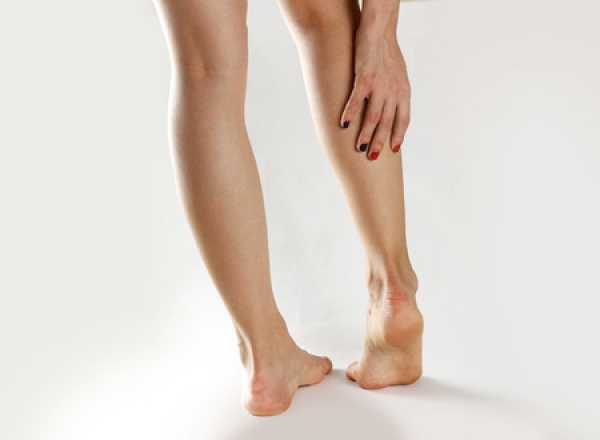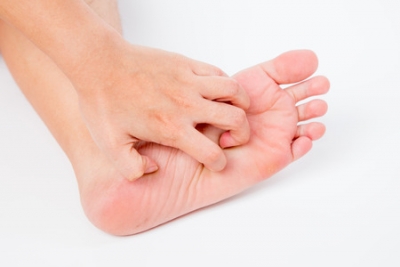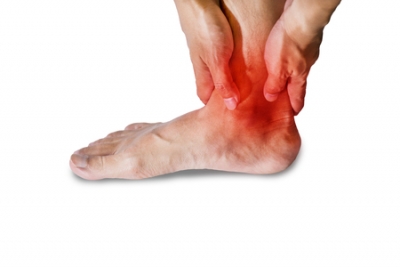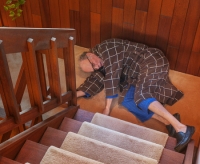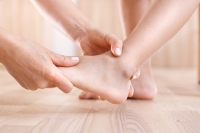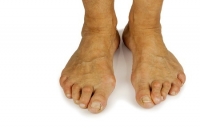Connect With Us
Blogs
Blog
Children categories
It’s the time of year for fright fests, haunted houses and all kinds of scary attractions, but at Superior Foot & Ankle Care Center we believe the podiatrist’s office shouldn’t be one of them! Many times, patients may get a diagnosis that sounds scary. In most cases, however, the name of a disorder may sound more frightening than it is. The job of our podiatrists, Dr. Victoria Foley and Dr. Constance Omelas is to make sure you understand a diagnosis and the treatment recommended for it. Your job as a patient is to ask questions until you feel confident that you comprehend your condition and treatment plan. Below are a few foot problems that illustrate our point.
Xerosis: while this may sound like a condition common to an ancient Greek god, it’s actually a term to describe very dry skin. Dry air, showering too frequently with very hot water or the soap you are using may all be the underlying cause. In some cases, dry skin can be a symptom of a systemic disorder. Usually, however, applying a super-rich moisturizer to your feet several times a day will eliminate xerosis.
Ganglions: you may be a little frightened when you start to experience numbness, tingling and pain in your feet for no apparent reason. Oftentimes, however, these symptoms are caused by small fluid-filled sacs that occur in the tendons or joints on the top of the feet or ankles. Repetitive stress to tendon linings and joints and shoes that constrict your feet are frequently the reason behind ganglions.
Brachymetatarsia: no, it’s not a pre-historic dinosaur. This term describes a defect in the growth of a toe bone that results in one of the metatarsals being shorter than the rest of the toe bones. It will commonly be seen in both feet. In some cases, this condition will not cause pain or discomfort, but it can affect balance so careful shoe selection will be necessary. For other patients, surgical remediation may be necessary.
Don’t hesitate seeking evaluation of foot or ankle symptoms. Putting off treatment is when foot conditions can truly become scary. Contact our Long Beach office today for an appointment by calling: (562) 420-9800.
At Superior Foot & Ankle Care Center a condition that we frequently see in both experienced athlete’s and “weekend warriors” is Achilles tendonitis. The Achilles tendon, also known as the heel cord, is a band of tissue that runs down the back of your lower leg, connecting your calf muscle to your heel bone. Although it is the strongest tendon in the body, it is also one of the most frequently injured. Inflammation of the Achilles tendon, known as Achilles tendonitis is an overuse injury which is caused by putting too much stress on the tendon too abruptly. If left untreated, the ongoing stress to the tendon prevents the body from repairing the injured tissue and the result is a continued pain. Below are some strategies for avoiding this common podiatric disorder:
- Slow and steady wins the race. And, it helps prevent Achilles tendonitis, too. If you have been inactive for a period of time and wish to resume or start a new exercise program, begin slowly. Gradually increase the length and intensity of your activity.
- Don’t choose pain before gain. Even experienced athletes can experience Achilles distress if they decide to significantly increase the difficulty of their workout. Running hills and stair climbing puts particular strain on the Achilles tendon and should not be suddenly increased.
- Stretch it out. One of the best ways for anyone to head off an Achilles tendon problem is by stretching. Exercises that specifically help to stretch and strengthen your calf muscles will help avoid tendonitis.
- Get some support. Patients with flat feet have a higher risk for Achilles tendonitis because as the arch flattens it increases the strain on the Achilles tendon and calf muscles. Be sure the shoes you wear (both on and off the field) have adequate arch support. Our podiatrists, Dr. Victoria Foley, and Dr. Constance Omelas may suggest a custom orthotic device to wear in your shoes for added support.
If you are experiencing soreness, aching or stiffness anywhere along your Achilles tendon, contact our Long Beach office (562-420-9800) to get it evaluated.
World Arthritis Day takes place in October and here at Superior Foot & Ankle Care Center, we’d like to take this opportunity to explore the relationship between food and joint health. Overall, we know that maintaining an appropriate weight greatly reduces the strain on your joints (and the rest of your feet), lowering your risk for arthritis and other foot problems. Below are some foods to choose or stay away from if you suffer from arthritis or other joint conditions:
Eat These:
Fish high in omega-3 fatty acids. These include salmon, sardines, tuna, anchovies, scallops and other cold-water fish. Omega 3’s have inflammation-fighting properties and research has shown that people who consume the highest amounts of them have the lowest levels of two inflammatory proteins in their bodies. If you can’t stand fish, take a fish oil supplement. A recent study found that 600-1,000 mg per day could ease joint swelling and pain and reduce the duration of morning stiffness in rheumatoid arthritis sufferers.
Fruits and Vegetables. Eating a rainbow of produce will give you many nutrients and antioxidants. Among the heavy hitters for reducing inflammation are: citrus fruits, red and purple fruits such as blueberries, strawberries and cherries and dark greens like spinach, kale and broccoli.
Good oils. Of course, all oil should be used in moderation but 2-3 tablespoons of olive oil a day can help reduce joint pain because it contains a compound that has properties similar to that of nonsteroidal, anti-inflammatory medications. Other “good oils” include safflower and avocado oil and also walnut oil which is high in omega 3’s.
Skip These:
Sugar. Foods with processed sugars (cakes, cookies, candy bars, sodas and fruit juices) release messengers called cytokines that actually create an inflammatory response in the body. Read labels because sugar has many names. Anything ending in “ose” is usually a sugar.
Saturated and Trans Fats. These trigger fat tissue inflammation which not only worsens arthritis but is an indicator of heart disease too.
Mono-sodium glutamate (MSG). Although most often found in prepared Asian foods and soy sauce, MSG is also added to many fast foods, soup mixes, salad dressings and deli meats. MSG opens 2 pathways to chronic inflammation.
Food is just one way to help control arthritis. If you are experiencing pain, stiffness and/or swelling of the joints in your feet and ankles, contact our Long Beach office by calling: (562) 420-9800. Our podiatrists, Dr. Victoria Foley or Dr. Constance Omelas will examine your feet and help develop a plan to best deal with your joint issues.
At Superior Foot & Ankle Care Center we treat many conditions that are made worse by the patient being overweight. The risk and severity of arthritis in the feet and ankles, metatarsalgia and flat feet, for example, are all increased by obesity. In addition, being obese increases the risk for diseases like diabetes and hypertension, which also have serious health consequences for your feet. September is National Childhood Obesity Awareness Month. Studies have shown that obese children tend to continue to be obese as adults. For that reason, it’s important to foster healthy lifestyle habits during childhood. Below are some do’s and don’ts to help your child maintain a healthy weight:
Do: strive to have your child spend at least 60 minutes a day being physically active. Encourage them to participate in a wide variety of activities to be sure they get exercise that is aerobic, muscle and bone strengthening. Not all activities have to be organized. Just playing in the yard children are likely to run, jump and climb which will give them all the types of exercise they need.
Don’t: force your child to be active if they complain of foot or ankle pain. If you suspect a podiatric problem is sidelining your child from being physically active, contact our Long Beach office (562-420-9800) for an appointment. Our podiatrists, Dr. Victoria Foley and Dr. Constance Omelas will examine your child’s feet to determine if there is an injury or other disorder that is causing them pain.
Don’t: allow unlimited amounts of time spent in front of a screen. If your child has full-time access to cell phone, television, computer and video games they are less likely to engage in physical activities.
Do: make changes in your family’s eating habits. Increase the number of fruits and vegetables in your menus, replace sugary drinks with water and have healthy snacks readily available. Involve your children in menu planning and grocery shopping and teach them how to make good food choices.
Do: set a regular bedtime for your child or teen that allows them to get enough sleep. Depending on your child’s age, they may need between 8 and 12 hours of sleep per night. Studies show that lack of sleep increases the risk of obesity.
Approximately 1 in 5 children today are obese. Working together, families and communities can help greatly reduce this number with lifestyle choices that will make for healthier children and, ultimately, healthier adults.
You may think you know about athlete’s foot—at least how to recognize it. A red rash that’s dry and flaky and itches and burns like crazy are the telltale signs. However, at Superior Foot & Ankle Care Center we know there’s more to know about this disorder than how it feels. Below are some important facts about this skin condition:
FACT: Athlete’s foot is a fungal infection. There are many different types of fungi that cause athlete’s foot. It’s necessary for our podiatrists, Dr. Victoria Foley and Dr. Constance Omelas to examine your feet and determine the fungus responsible for the outbreak in order to prescribe the correct medicine.
FACT: Athlete’s foot is easily spread to other parts of the body. Fungal toenails and jock itch, for example, can develop when you touch a spot on your feet that has athlete’s foot and then touch someplace else on your body. Athlete’s foot is also extremely contagious to other people.
FACT: Fungi love moist, warm, dark places. Gym locker rooms, the cement around the town pool, public showers, nail salons and the insides of closed-in shoes are all prime spots for fungi to grow.
FACT: You can greatly reduce the risk of getting athlete’s foot if you keep your feet covered when walking in public places and avoid sharing soap, towels, footwear, nail clippers and any other items that touch another person’s foot.
FACT: Personal care habits can also decrease your risk of athlete’s foot. You should wash your feet every day and dry them completely. Using a talcum foot powder on your feet before putting your socks on can help keep feet dry.
FACT: Your footwear choice is important if you are prone to athlete’s foot. Look for socks designed to specifically take moisture away from your feet. Change your socks during the day when you notice that your feet feel moist. Choose shoes that allow air to circulate and feet to breath.
Good podiatric care can help eliminate your chances of getting athlete’s foot. If you have a chronic fungal foot infection problem, contact our Long Beach office (562) 420-9800) to learn ways to get permanent relief.
Do you constantly feel like your ankle is going to “give out?” Does walking on uneven surfaces, in high heels or stepping off a curb frequently cause your ankle to turn? If so, you may be suffering from chronic ankle instability, a condition that we at Superior Foot & Ankle Care Center know many patients find very frustrating.
Causes of Wobbly Ankles
In nearly all cases, at the root of a weak ankle condition is a previous ankle injury or problem. Common sources include:
- One or more ankle sprains
- Scar tissue formation following a sprain
- Fracture in the ankle joint bones
- Arthritis or other inflammatory condition of the ankle joint, tendons or joint lining
- Nerve damage in the ankle area, such as stretching, tearing or pinching of the ankle nerves
Sometimes patients fail to complete the full course of rehabilitation for an ankle injury. Physical therapy and other treatments are geared toward healing the overstretched ankle ligaments and also strengthening the muscles that surround the ankle. When the pain stops, that’s when a patient stops therapy. Unfortunately, that doesn’t mean the ankle is fully healed. Going back to normal activities can lead to another sprain because the ankle is still weak. The more injuries, the weaker the ankle becomes.
Breaking the Cycle
The first step is getting your ankles evaluated. Our podiatrists, Dr. Victoria Foley or Dr. Constance Omelas will examine your ankles and feet. The foot doctor will also ask questions about previous injuries, your medical history and recent activities. Digital x-rays (which can be done right in our Long Beach office) and/or other imaging studies may also be ordered to help get a clear picture of the condition of the ankle bones and joints.
Depending on the cause and extent of the ankle damage, a treatment plan will be developed which may include:
- Anti-inflammatory or steroidal medications prescribed on a temporary basis to decrease swelling
- Ankle braces or supports
- Immobilizing the ankle area if there is a fracture that needs to heal
- Physical therapy to strengthen and improve range of motion for ankle muscles
If you have weak ankles, don’t wait to get treatment. Contact us today by calling (562) 420-9800.
National Fall Prevention Awareness Day takes place this month. At Superior Foot & Ankle Care Center we want all of our patients to be healthy and active. If you have a loved one age 65 or over, we encourage you to talk to them about the risk of falling. One in four Americans in this age group fall each year. The good news is that many falls are preventable. Start the conversation with the older people in your life and help them discover ways they can lower their fall risk. Below are some suggestions on how you can offer your help.
Encourage Independence
Studies show that one reason seniors who have stumbled or fallen don’t tell their families is that they fear losing their independence. Tell the person you care about that you want them to be independent and are talking to them now about fall risks to help them stay independent. Give them an opportunity to be honest about any concerns they have about falling.
Checkup on Medical Conditions
Ask the older people in your life about their health and any new concerns they may have. The feet are an obvious starting point. Foot and ankle pain can cause a person to alter the way they walk, and this can throw off their balance and result in a fall. Encourage an elderly person who complains of foot pain to contact our Long Beach office and make an appointment with one of our podiatrists, Dr. Victoria Foley or Dr. Constance Omelas to find out the cause and treatment of foot problems promptly. Getting eyes checked regularly is another important way to prevent falls. It’s also a good idea to suggest that the older person you love periodically review all their medications with their pharmacist or physician. Dizziness or lightheadedness can occur due to medication interactions or if the dosage needs to be adjusted.
Help with a Home Makeover
Over 50% of all falls occur at home. Do a walk through with your loved one and look for ways to improve safety. Consider the following:
- Removing throw rugs
- Adding a railing on both sides of the stairs
- Increasing light indoors and outdoors
- Painting outdoor steps with non-slip paint
- Installing grab bars in the bathroom
Keep Talking
Let your loved one know that you’re available if they have other thoughts about how to decrease their risk of falls and to discuss any concerns they have. Be reassuring and keep the doors of communication open. If you or your older loved one have any questions about foot health and fall prevention, don’t hesitate to call us at (562) 420-9800.
At Superior Foot & Ankle Care Center we know that tracking down the source of foot pain in children can be challenging. A condition that often affects children between the ages of 8 and 14 is Sever’s Disease, also known as calcaneal apophysitis. Until your child passes through puberty, his or her legs and feet continue to grow and develop. Sometimes the heel bone can grow faster than the tendons and muscles of the leg. This can result in a feeling of tightness and pressure in the heel. The back of the growth plate has a vulnerable spot where new bone growth forms. Continuous stress on the heel caused by running, jumping and wearing cleats can inflame the growth plate. High-risk sports include soccer, football, track, basketball and gymnastics.
Signs and Symptoms
Pain in the bottom of the heel, a loss of flexibility, or a feeling of tiredness in the foot are the primary symptoms of Sever’s Disease. There also may be some swelling in the affected area. Young children, however, may not be able to articulate their symptoms. Look for these signs that heel or other foot pain may be occurring:
- Limping
- Walking on tip toes
- Claiming to be tired and not wanting to play
- Avoiding sports and other physical activities that your child usually enjoys
Getting Relief
Our podiatrists, Dr. Victoria Foley and Dr. Constance Omelas will develop a treatment plan to help relieve pain and inflammation. This will most likely include resting the heel and avoiding sports and activities that aggravate it as well as any of the following:
- Icing the heel
- Anti-inflammatory medications
- Heel cushion inserts or orthotics
- Exercises to stretch and strengthen lower leg muscles and tendons
Sever’s Disease does not have any long-term effects as long as your child takes a break from activities that are putting a strain on the heel and allows the inflammation to go away. It’s important, however, not to ignore signs of foot pain in young athlete’s or encourage them to “play through the pain,” as damaging injuries can then occur.
If you have questions about your child’s foot health, contact our Long Beach office today by calling: (562) 420-9800.
Bunions are a condition that we at Superior Foot & Ankle Care Center treat often. A bunion is a deformity of the toe joint that most often affects the big toe. It causes the joint to move out of place and drift toward the second toe. Bunions can have a number of different causes, including:
- Neuromuscular problems
- Flat feet
- Recurring stress to the foot
- Congenital defects
- Previous injury
- Arthritis
- Ill-fitting footwear
Bunions are a progressive disorder, which means they will continue to get worse over time. Our podiatrists, Dr. Victoria Foley or Dr. Constance Omelas will start by doing a complete physical examination of your feet. While conservative measures are always preferable, if your bunion has progressed to the point where it is impeding your ability to wear shoes and walk without pain, surgery may be the best treatment option. Below are some questions to ask before scheduling bunion surgery:
What type of bunion surgery do you recommend? There are several different kinds of bunionectomies. The foot and ankle surgeon will choose the type that best addresses the structural changes that have occurred to your toe because of the deformity. Ask the podiatrist to thoroughly explain the surgical procedure and ask questions if there is anything you don’t understand.
Where will the surgery take place? Bunion surgery is usually performed on an outpatient basis under local anesthesia. It will be necessary to have someone drive you home so be sure to arrange for that before the date of the surgery.
What will the recovery be like? You will have to avoid bearing weight on the affected foot for some period of time after the surgery. Ask the foot doctor how long you will need to be out of work. In addition, you’ll want to know how much discomfort to expect post operatively. Even after you are able to bear weight and return to work, you may need to do physical therapy or use a custom orthotic. Find out what results the podiatrist expects from the surgery and what the post-surgical treatment plan will consist of.
Knowing what to expect for your bunion surgery will reduce worry and help you better prepare for the modifications to your schedule. If you have additional questions, don’t hesitate to contact our Long Beach office by calling: (562) 420-9800.
Fall sports practices are in the works and for children and teens that have spent the summer on the couch with a phone or video controller glued to their hands, it can be a shock to their feet to begin a strenuous sports routine. Below are 5 ways we at Superior Foot & Ankle Care Center recommend to ease the transition and protect young feet:
- Start working out. Have your child contact their coach for some suggested pre-season warm-ups. Stress fractures, Achilles tendonitis and other overuse injuries are common when patients overdo physical activity after being a couch potato for a couple of months.
- Find active ways to enjoy family fun. There’s still time for family bike rides, hikes, rollerblading and other physical activities. Not only will this help everyone get in better shape, it’s a great way to enjoy some time together before the hectic fall schedules kick in.
- Read up on a favorite athlete. Who is your child’s sports idol? Encourage them to look up interviews and information about how he or she trains during the offseason. It may give your child the incentive and inspiration necessary to get started.
- Buy new shoes. If your child is starting a sport it’s a good idea to get athletic shoes designed to support their feet for the activity they will be doing. Go to a professional fitness shoe store to get fitted and learn about the best options for your child’s foot. If your child is returning to a sport, check to see that their shoes fit and that there is no evidence of excessive wear. Worn soles, stretched out heel counters and creased uppers are all signs that it’s time to replace the shoes. Wearing shoes that are stretched out or falling apart invites injuries.
- Get a podiatric checkup. This is particularly important if your child has had an ankle sprain, fracture or other sports injury in the past. Our podiatrists, Dr. Victoria Foley and Dr. Constance Omelas will examine your child’s foot to ensure that the injury is completely healed. To make an appointment at our Long Beach office, call: (562) 420-9800.
More...
We tend to take our feet for granted. Every day we get up out of bed, put on shoes and go on about our day—standing, walking, running, maybe even hiking, dancing and playing a sport. At Superior Foot & Ankle Care Center we thought it might be fun to take a look at some facts about your feet:
- Each of your feet contains 26 bones (that is nearly a quarter of all the bones in your body!), 33 joints and over 107 ligaments and 19 muscles and tendons.
- Your feet have more nerves per square centimeter than any other part of your body—over 8,000 in total.
- The average person walks about 115,000 miles over the course of their life—that’s equal to circling the earth four times.
- Women typically walk 3 miles more a day than men.
- Your feet have approximately 250,000 sweat glands which produce up to ½ pint of perspiration each day.
- Most people have one foot that is larger than the other.
- About 75% of Americans will experience foot problems at some point in their lives and women have foot pain four times more often than men.
- 9 out of 10 people are wearing shoes that are too small for their feet.
- Over 50% of American women have bunions—a toe deformity where the big toe drifts over to the second toe, forcing the joint out of place and creating a bump on the outside of the big toe.
- Foot size on average has increased two sizes since the 1970’s. The reason behind this is thought to be that feet are getting larger in order to support extra pounds as the average weight of people also continues to climb.
- It takes 5-6 months to grow a completely new toenail. Toenails grow faster in warm weather, during teenage years and pregnancy.
Now that you know just how incredible your feet are, our podiatrists, Dr. Victoria Foley and Dr. Constance Omelas, want to encourage you to be proactive in the care of them. If you experience any pain or discomfort, don’t delay. Contact our Long Beach office promptly for evaluation and treatment by calling: (562) 420-9800.
On August 17th we at Superior Foot & Ankle Care Center want our patients to recognize a special occasion: “I Love My Feet” Day. Your feet are the transportation for your body. Although often taken for granted, there’s not much you can do without them. So, take this opportunity to treat your feet to something special. Below are a few suggestions:
Foot massage
Get a professional foot massage or give yourself one (there are lots of how-to’s online). Foot massage can relieve soreness after a long day spent on your feet. It also can help with certain chronic foot disorders like arthritis, flat feet and plantar fasciitis as well as improve circulation and reduce stress. Plus, it just feels soooo good!
Upgrade your shoes
Do an inventory of your shoe wardrobe. Throw out any shoes that are worn out or hurt when you wear them (hint: ones with heels over two inches and narrow, pointy toe boxes are likely offenders). If you spend a large amount of time in flip-flops, invest in a pair that has arch support to prevent heel and arch pain.
Start doing self-exams
One of the best ways you can care for your feet is by doing regular self-exams on them. Look over your entire foot, top and bottom. Check for changes in color, bruising, rashes, bumps, cuts that don’t seem to be healing and changes in moles or freckles. Inspect toenails to make sure they are not growing inward or showing signs of a fungal infection (crumbling at the edges, discoloration). Stretch your feet, wiggle your toes and rotate your ankles—any pain, stiffness or limitations in range of motion? If you notice anything abnormal or questionable, make an appointment at our Long Beach office so that one of our podiatrists, Dr. Victoria Foley and Dr. Constance Omelas can examine your feet and determine if anything is wrong.
Put them up
Give your feet a break! Elevate them at the end of the day to a height higher than your heart if possible. This will help with swelling and circulation and also give them some much-deserved rest.
If you have questions about other ways to improve the health and well-being of your feet, contact us by calling: (562) 420-9800.
You didn’t see South Korea’s Chung Hyeon at Wimbledon early this month. That’s because he pulled out at the last minute due to an ankle injury that was not fully rehabilitated. At Superior Foot & Ankle Care Center we think Mr. Hyeon is a winner for making that choice. Chronic ankle pain and instability is most often the result of a prior ankle sprain or strains or other ankle injuries that were not fully healed before the patient resumed normal activities. A mistake that many patients make is stopping their physical therapy once the ankle is pain-free. However, in addition to healing the injury and retraining the ligaments of the ankle, it’s essential to strengthen the muscles surrounding the ankle to help prevent future twists and injuries. This takes time and when patients terminate physical therapy before this occurs they open themselves up to the possibility of repeated ankle injuries.
Recognizing Chronic Ankle Issues
While some symptoms of a chronic ankle problem are obvious, some are subtler. For example, lower leg pain and pain on the outside of the ankle may indicate an ankle issue. Other symptoms include:
- Stiffness or tenderness in the ankle on a regular basis
- Swelling of the ankle area
- A feeling that your ankle is going to “give way,” or repeatedly twisting your ankle on unlevel surfaces or when wearing high heels
Treatment Options
If you are having intermittent or ongoing ankle discomfort, it’s important that you make an appointment with one of our foot and ankle surgeons, Dr. Victoria Foley and Dr. Constance Omelas to have your ankle evaluated. In addition to physically examining your ankle for tenderness and swelling, the foot doctor will ask questions about previous ankle injuries. She may also wish to get an x-ray or other imaging studies to get a clear picture of the condition of your ankle. Once the podiatrist knows the state of your ankle a treatment plan that best suits you can be developed. It may include:
- Over the counter or prescription medications to take temporarily to reduce inflammation and swelling
- Ankle braces or supports to increase stability
- Physical therapy and exercises to strengthen muscles and improve range of motion.
To learn more, contact our Long Beach office by calling: (562) 420-9800.
Did you know that the leading cause of lower extremity amputations not caused by trauma is diabetes? And, foot ulcers precede 85 percent of these amputations. At Superior Foot & Ankle Care Center we want patients to know that diabetic foot ulcers can be prevented and our podiatrists, Dr. Victoria Foley and Dr. Constance Omelas will work with you to develop a care regimen and monitor your feet as a diabetic patient. Adhering to a schedule of regular podiatric checkups is an important step in protecting your feet if you have diabetes. Below are other areas where you can be proactive in preventing ulcers:
Healthy Foot Habits—in addition to regular podiatric exams, doing your own self-exams at home is also very important. Foot ulcers commonly form on the soles of the feet so be sure you check the bottom of your feet carefully (or have someone do it for you) and the rest of your feet as well on a daily basis. Report any redness, sores, blisters, rashes or cuts to the foot doctor asap. You should also wash your feet daily and dry completely. Use foot powder and change your socks whenever you notice that your feet feel damp. This will reduce the risk of bacterial and fungal conditions which can lead to infections and wounds.
Footwear—the shoes you wear can play a big part in preventing conditions that can lead to wounds. Choose styles that are made of soft, flexible material and have wide, roomy toe boxes. Shoes that squeeze toes together can increase the risk of ingrown toenails and blisters and hasten the progression of toe problems like hammertoes and bunions. Periodically run your hand around the inside of your shoes to make sure there are no small pebbles stuck inside or loose stitching that can rub against the skin and cause an irritation.
Lifestyle Choices—one of the most important steps you can take for preventing ulcers is keeping your blood sugar levels where they should be. Follow the dietary plan your doctor has given you and fill your menus with nutrient-rich foods that are low in sugar. Don’t smoke because it impedes circulation. Limit alcohol use as this has been linked with an increased risk of foot ulcers.
If you have diabetes and have additional questions about how to best care for your feet and prevent diabetic complications, contact our Long Beach office by calling: (562) 420-9800.


